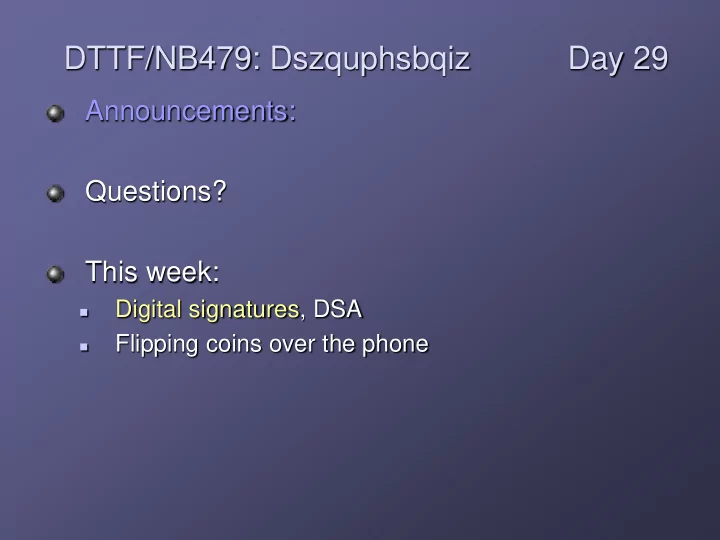

DTTF/NB479: Dszquphsbqiz Day 29 Announcements: Questions? This week: Digital signatures, DSA Flipping coins over the phone
Why are digital signatures important? Compare with paper signatures Danger: Eve would like to use your signature on other documents! Solution: sig = f(m, user) Let m be the message (document) Algorithms we’ll study: RSA ElGamal DSA (Digital Signature Algorithm)
1 RSA Signatures Alice chooses: p,q, n=pq, e: gcd(e, (p-1)(q-1))=1, d: ed ≡ 1(mod ((p -1)(q-1)) [d is the “pen” Alice uses] Publishes n, e [“glasses” Bob uses to see the writing] Alice’s signature uses the decryption exponent : y ≡ m d (mod n). Delivers (m, y) Bob’s verification: Does m ≡ y e (mod n)? Show the verification works. (Q1) Note that given only the signature y, and public info e and n, Bob can compute the message, m.
2 RSA Signatures Alice chooses: Eve’s schemes: Can she use Alice’s signature on p,q, n=pq, a different document, m 1 ? e: gcd(n, (p-1)(q-1))=1, d: ed ≡ 1(mod ((p-1)(q-1)) Can she compute a new y 1 , so Publishes n, e e ? that m 1 = y 1 Alice’s signature: Can she choose a new y 1 first, y ≡ m d (mod n). Delivers (m, y) e ? then compute m 1 = y 1 Bob’s verification: Does m ≡ y e (mod n)?
3-4 Blind Signature Alice chooses: Bob wants Alice to sign a document as a method of p,q, n=pq, time-stamping it, but e: gcd(n, (p-1)(q-1))=1, doesn’t want to release d: ed ≡ 1(mod ((p-1)(q-1)) the contents yet.* Publishes n, e Bob wants m signed Verification: Bob chooses: Find sk -1 in terms of m k: random, gcd(k, n)=1 What is the significance of Bob sends: t ≡ k e m (mod n) this? Alice’s signature: s ≡ t d (mod n). Why can’t Alice read m? Bob’s verification: What’s the danger to Computes sk -1 Alice of a blind signature? * He can publish her signature, which can be verified later, or he can submit it to an authority to obtain an actual timestamp: http://en.wikipedia.org/wiki/Trusted_timestamping
ElGamal Signatures don’t reveal the message during verification Many different valid signatures for a given message Alice chooses: p,primitive root α , β ≡ α a (mod p) Publishes (p, α, β ), keeps a secret Alice’s signature: Chooses k: random, gcd(k, p-1)=1 Sends (m, (r,s)), where: r ≡ α k (mod p) s ≡ k -1 (m – ar) (mod p-1) Bob’s verification: Does β r r s ≡ α m (mod p)?
5-7 ElGamal Signatures Many different valid signatures Notice that one can’t compute for a given message m from (r,s). Alice chooses: p,primitive root α , secret a , Show the verification works. and β ≡ α a (mod p) Publishes (p, α, β ), keeps a Why can’t Eve apply the secret signature to another message? Alice’s signature: If Eve learns a, she can forge Chooses k: random, the signature gcd(k, p-1)=1 Sends m, (r,s), where: r ≡ α k (mod p) Note: Alice needs to randomize k each time, else s ≡ k -1 (m – ar) (mod p-1) Eve can recognize this, and can compute k and a relatively Bob’s verification: quickly. Does β r r s ≡ α m (mod p)?
Recommend
More recommend